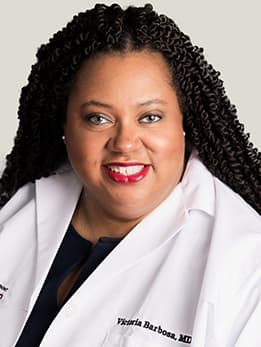Hair loss in women: Causes, prevention and treatments

Introduction to the authors
Women experiencing hair loss often suffer in silence because they’re too embarrassed to talk about it or think it’s just a cosmetic problem. Maybe they’ll mention it to their friends or hairstylist, but rarely to their doctor.
That’s something doctors at the Victoria Barbosa, MD, MPH, leads the program. After a thorough examination to identify the type of hair loss, each patient receives a personalized care plan. This is important because different types of hair loss have different treatments, and hair loss is sometimes related to other underlying health issues that need to be addressed.
Barbosa’s expertise includes managing hair issues specifically affecting Black women. She also organizes quarterly Zoom support group meetings and a series of educational webinars.
Obstetrician-gynecologist Monica Christmas, MD, is an expert on menopause and hormonal changes that can contribute to hair loss.
While some hair shedding is normal, it’s important for women who are losing an excessive amount of hair to understand why it is happening, how to prevent further hair loss and how to treat it.
What causes hair loss?
A lot of different things contribute to hair loss, also known as alopecia, in women. It’s often a combination of factors. The most common causes of sudden rapid hair loss, or telogen effluvium (TE), are stress and fluctuating hormones, especially after pregnancy. Hair might also fall out after a major illness or injury, but the shedding usually doesn’t happen until a few months later, regardless of the trigger. Female pattern hair loss is also very common and is hereditary. It’s more prevalent after menopause because hormones sometimes play a role. Some hairstyling techniques and products can lead to hair loss. So can certain medications, other scalp diseases or a poor diet with nutritional deficiencies. Hair loss is sometimes tied to underlying health conditions, such as thyroid disorders, anemia and autoimmune disease.
How much hair loss is normal?
It’s normal to lose up to 100 hairs a day. That’s a lot of hair! Sometimes we ask women to do a hair count over 24 hours to see if they’re losing more than that.
Can stress make it worse?
Yes. It could be either physical stress, such as a broken bone, or emotional stress. In 2020, we all had a lot of emotional stress and we saw a huge increase in the number of people with TE who suddenly started losing clumps of hair. Stress also can exacerbate forms of hair loss like alopecia areata, an autoimmune disease. Stress shedding is temporary. It starts two to four months after a stressful event, and can last anywhere from two months to two years. Even if you learn to manage your stress, that doesn’t mean the shedding will be controlled right away. Eventually the shedding improves on its own, but it is often distressing.
At what age does hair loss typically start?
Different types of hair loss typically start at different ages. A common type of hair loss in women is an inherited condition known as androgenic alopecia, or female pattern hair loss. It usually begins when a woman is in her 40s or 50s, but it could start later, or as early as puberty. It starts with a gradual thinning of the hair, usually near the part. For some women, it’s connected to an underlying medical condition. Our team of menopause experts are experienced in treating symptoms related to menopause, including hair loss.
Do chemicals and certain hair styles contribute to hair loss?
Yes. Relaxers, dyes and other chemicals can strain and damage hair shaft. Styling techniques, such as tight braids, can cause hair loss from the root, a condition called traction alopecia. Often these practices can cause permanent damage to the follicles over time. It helps to have a dermatologist who understands differences in hair type and can advise in healthy styling practices.
What can women do to prevent hair loss?
Have a well-balanced diet and get enough iron, zinc, and vitamins D and B. Also, be gentle to your hair and follicles. Avoid hairstyles that cause pulling. Minimize the use of direct heat on the hair and keep hair well-conditioned. Natural oils like argan oil, Jamaican black castor oil or olive oil may help. Over-the-counter products, such as minoxidil, laser caps or helmets, may provide some benefit. It takes up to four months for any of these treatments to work. If after four months there is no improvement, then it’s time to make an appointment with a doctor.
When should you talk to your doctor about it?
Hair loss can be painful, both physically and emotionally. It’s never too early to see a doctor if you’re concerned about the amount of hair loss, or if it runs in your family. If you have an underlying condition, such as a thyroid disorder, iron or vitamin deficiency, or autoimmune disease, it helps to have a specialist provide recommendations to keep your hair healthy.
What types of treatments are available?
A UChicago Medicine dermatologist can diagnose the cause of your hair loss. Our specialists can explain the pros and cons of different treatments depending on the type of alopecia you are experiencing, including prescription oral and topical medications, hair growth supplements and over-the-counter drugs. The doctor also might recommend steroid injections, low-level laser therapy, platelet-rich plasma therapy, hair transplantation or even a diet tweak.
Are there any new treatments on the horizon?
Research is moving quickly and there are more treatments than ever before. Newer therapies include use of platelet-rich plasma, or PRP, for some forms of hair loss. Certain medications, such as oral minoxidil and finasteride, are also being used.

Victoria Barbosa, MD
Victoria Barbosa, MD, is a board-certified dermatologist. She provides specialized care for a broad range of skin and hair conditions.
Learn more about Dr. Barbosa
Monica Christmas, MD
Monica Christmas, MD, offers comprehensive obstetric and gynecologic care from a patient’s initial exam through her childbearing years and menopause.
Learn more about Dr. Christmas.